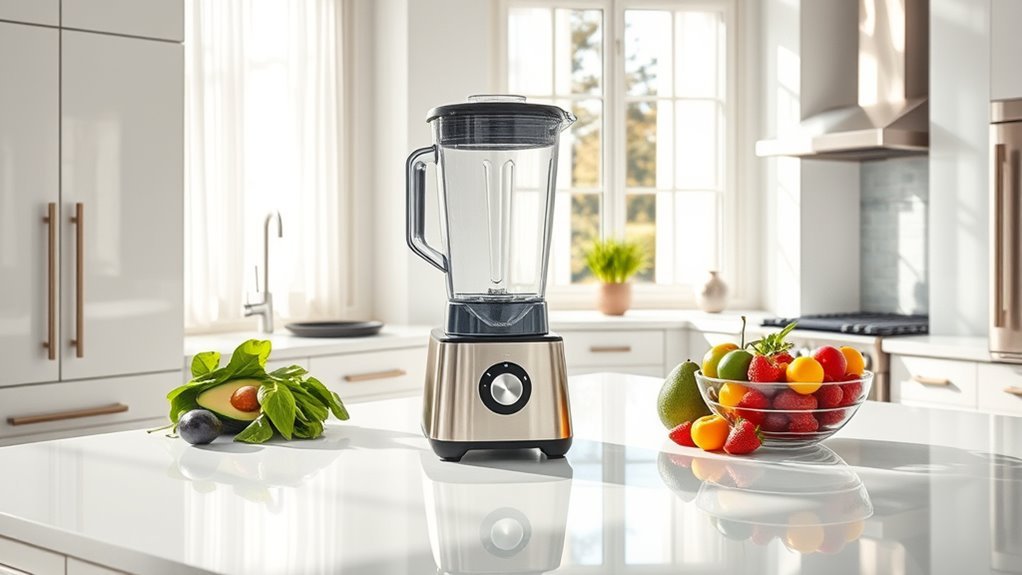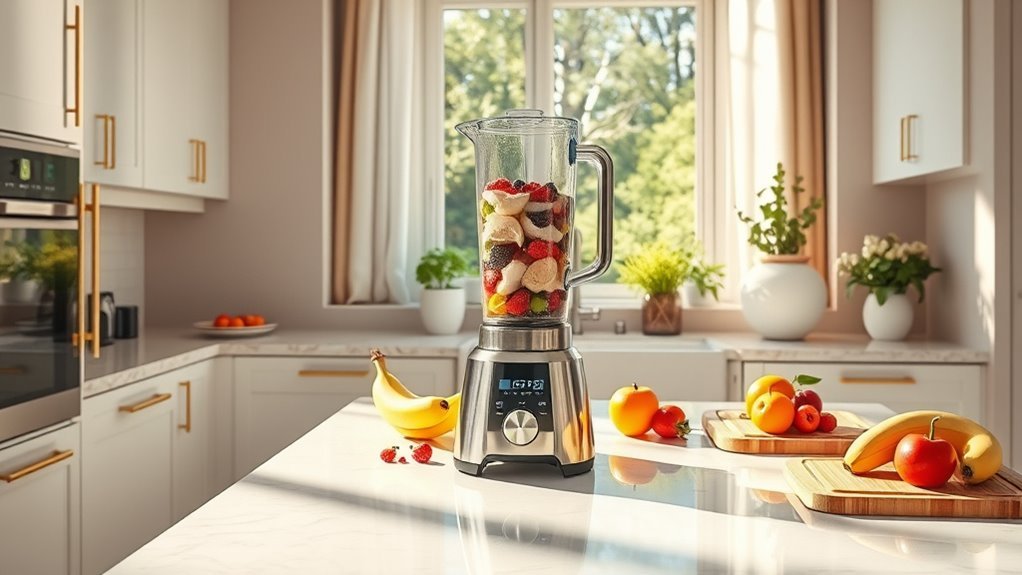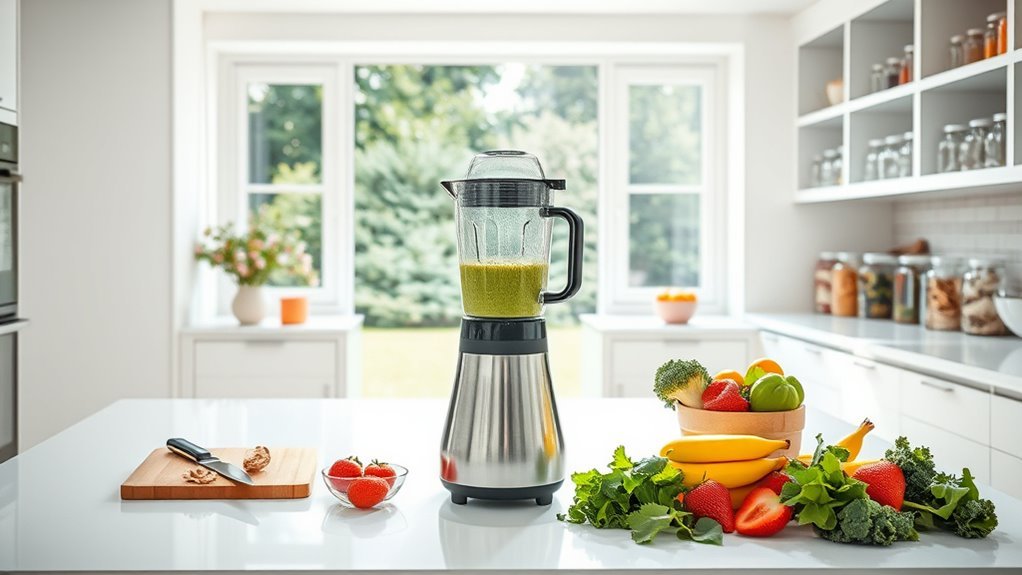We’ll achieve silky-smooth textures through strategic pulse blending methods. Start with short ¼ to 2-second bursts for firm ingredients, then layer in softer items while maintaining proper liquid ratios (1:2 to 1:3 for smoothies). Control temperature by pre-chilling ingredients and containers, then combine low-speed pulses to break down tough items with high-speed bursts for final smoothness. Master these techniques, and you’ll reveal professional-grade results in your kitchen.
Understanding Pulse Timing Sequences

Three key elements define effective pulse timing sequences: duration, frequency, and purpose. When we’re working with the pulse setting, we’ll typically use short bursts ranging from ¼ to 2 seconds to control the consistency of our ingredients.
Think of each pulse as a precise chop – too long, and we’ll overshoot our target texture.
Let’s be clear: mastering pulse timing isn’t rocket science, but it requires attention. We’ll start with larger ingredients, using deliberate pulses to break them down before switching to continuous blending.
Want chunky salsa? Short, quick pulses. Need finer texture? Slightly longer bursts. By varying these intervals, we’re fundamentally conducting a symphony of textures, adjusting on the fly until we hit the sweet spot. Additionally, using a high-performance blender can greatly enhance our ability to achieve desired textures due to its powerful motor and sharper blades.
Layered Ingredient Processing Strategy
When we’re aiming for perfect texture control, layered ingredient processing becomes our secret weapon.
We’ll start with firm ingredients like carrots or nuts, hitting the pulse button intermittently until we achieve our desired consistency. This strategic approach prevents over-processing while maintaining ingredient integrity.
Next, we’ll introduce softer ingredients gradually. Think of it as building layers of texture – from firmest to most delicate. By controlling each layer’s processing time, we’re crafting a blend where every component contributes precisely what it should.
The result? A harmonious mixture where carrots don’t turn to mush and avocados don’t disappear into oblivion. Additionally, using a high-performance blender allows for enhanced versatility in the kitchen, making this method even more effective.
Trust us – this method delivers superior results every time. You’ll get perfect texture control and enhanced flavor profiles that’ll make every blend worth the extra attention to detail.
Temperature Control for Optimal Texture

Temperature mastery stands as the cornerstone of achieving flawless textures in your blends. We’ll show you how precise control transforms ordinary mixtures into culinary masterpieces.
For hot ingredients, let’s get tactical: cool them slightly before blending to prevent steam explosions and texture mishaps.
When making smoothies, pre-chill your ingredients and container – it’s not just about taste, it’s about maintaining that perfect consistency.
Temperature control isn’t just about ingredients; it’s about technique. Use the pulse feature strategically to prevent overheating during blending.
Short bursts give you maximum control while keeping temperatures in check. Think of your blender as a precision instrument – when you monitor heat levels and adjust your approach accordingly, you’ll nail that ideal texture every time.
Multi-Speed Pulse Combinations
Master-level blending demands more than just hitting the “on” switch – it’s about orchestrating a symphony of speeds and pulses.
We’ll show you how multi-speed pulse combinations reveal texture control that’ll revolutionize your blending game.
- Start with quick bursts at low speed to break down tough ingredients, then shift to high-speed pulses for smoothness.
- Control to adjust pulse duration gives you precise texture management – perfect for chunky salsas or silky soups.
- Combine rapid pulses with sustained blending to eliminate ice chunks in smoothies.
Let’s be clear – mastering these combinations takes practice.
But once you’ve got the rhythm down, you’ll create everything from perfectly chunky guacamole to velvety bisques.
It’s all about timing your pulses and reading how your ingredients respond to different speeds.
Liquid-to-Solid Ratio Mastery

The science of liquid-to-solid ratios forms the backbone of exceptional blending. We’ve mastered the perfect proportions to transform ingredients from rough to sublime. Let’s reveal the secrets of ratio mastery with this essential guide.
| Blend Type | Liquid-to-Solid Ratio |
|---|---|
| Smoothies | 1:2 to 1:3 |
| Purées | 1:2 |
| Sauces | 1:1.5 |
| Dips | 1:3 |
| Chunky Salsa | 1:4 |
Think of liquid ratios as your control dial. Want a velvety smoothie? Stick to 1:2. Craving chunky salsa? Dial it back to 1:4. We’re not just throwing ingredients together – we’re engineering texture. Higher liquid content means smoother blending and better flavor extraction. But here’s the kicker: too much liquid turns your masterpiece into soup. Master these ratios, and you’ll nail the perfect consistency every time.
Advanced Container Movement Techniques
While many focus solely on speed settings, mastering container movement revolutionizes your blending game. When using your blender’s pulse feature, strategic container manipulation guarantees whole fruits and vegetables blend evenly, transforming your blending system into a precision instrument.
- Combine circular motions with gentle tilts to guide ingredients toward the blades – this prevents dead zones where food gets stuck.
- Master the up-down container dance during pulsing to create dynamic movement, perfect for stubborn ingredients that resist blending.
- Time your pulses strategically: quick bursts for coarse textures, longer pulses for smoothness.
We’re not just randomly pressing buttons here – we’re conducting a symphony of movement that turns chunky ingredients into silky perfection. Let the container become an extension of your culinary instincts.
Targeted Texture Achievement Methods
Professional pulse blending opens up a world of precise texture control that’ll transform your culinary creations from amateur to expert-level.
Let’s master this essential technique.
We’ll start by using quick bursts of the pulse function to chop ingredients evenly – perfect for chunky salsas where texture balance is key.
For silky-smooth purées, we pulse first to break down larger pieces, then gradually increase to continuous blending. Trust us: this method prevents those annoying chunks.
Want perfectly textured nut butter? Alternate between pulsing and steady blending. You’ll get that ideal mix of creamy spread with subtle crunch.
For herb-based sauces like pesto, short pulses are your secret weapon. They’ll prevent that dreaded soupy mess while maintaining the perfect consistency.
Frequently Asked Questions
What Is Pulse Blending?
We use pulse blending techniques to control ingredient textures through quick power bursts. It’s advantageous for precise chopping and has various applications, from creating chunky salsas to preparing delicate ingredients.
What Does “Pulse Until Smooth” Mean?
When we’re making hummus, “pulse until smooth” means we’ll use short bursts of blending, controlling our pulse timing strategies until ingredients reach that silky consistency we want through gradual texture enhancement.
What Does P Stand for in a Blender?
When we’re using our kitchen appliances, the “P” on blenders stands for “Pulse,” one of the essential blender features that lets us control blending techniques with short bursts of power.
What Is the Pulse Mode on a Vitamix?
We use Vitamix’s pulse mode for precise blending techniques, activating short power bursts that let us control texture in smooth recipes without over-processing our ingredients. It’s a key feature for customized results.

